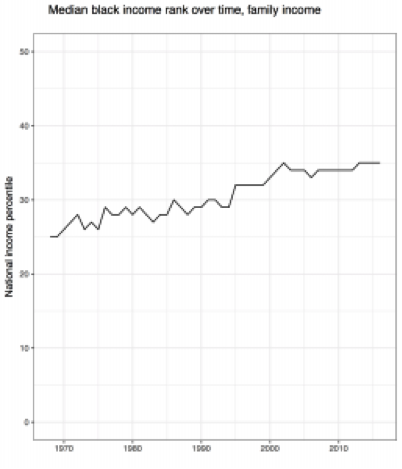Over the last 50 years in America, the gap between what the typical black household earns and what the typical white household earns has barely budged. According to a report published last month by the Economic Policy Institute, the median black family’s household income in 1968 was 59 percent of the median white family’s income; in 2018, it was only 61.6 percent.
The stubborn persistence of this gap has been the topic of a lot of research and discussion. How is it possible, policymakers have wondered, that black families could have made so little progress in spite of dramatic shifts in social norms and concerted efforts on the part of the federal government to address these gaps? Over the years, researchers have studied a variety of possible explanations—from outright discrimination in the labor market, to disparities in access to education, to occupational segregation, to the lower levels of family wealth African-American families hold, to differing family structures.
In general, all of these factors seem to play a role. It’s still true that African Americans face discrimination in the labor market. And it’s still true that the lower levels of wealth in African-American families make it harder to climb the ladder. And that African Americans are less likely to work in “high-status,” high paying jobs and less likely to attend elite colleges and universities. These gaps, however, have narrowed. Yet the income gap persists.
“The persistence of the racial income gap is, of course, problematic, but it’s also confusing,” says Robert Manduca, a Ph.D. student at Harvard University whose research we’ve covered before. “Because there’ve been all these government programs, there’ve been improvements in the various inputs to the earnings gap (like education). We’ve even seen improvements in life expectancy. The progress is definitely not complete, but the gaps have narrowed, so it’s been a bit puzzling as to why this hasn’t translated to improvements in the income gap.”
In a new paper, Manduca suggests another explanation for the gap, one that’s received little attention: the rise in income inequality.
Contrary to the dominant rhetoric on the topic, African Americans actually have made some significant progress with respect to white families when it comes to income rank, a measure of where the median family sits on the income distribution. In 1968, the median African-American family was at the 25th percentile of the income distribution. By 2016, the median African-American family was at the 35th percentile of the distribution. The chart below, from Manduca, illustrates this progress:

The problem is that this progress occurred during a time period where wages for the bottom part of the income distribution stagnated, while the earnings of those at the top skyrocketed.
“The way that I think about it is that if you compare the income at the 35th percentile to the national mean, the average family income—in 1968, a family at the 35th percentile earned 69 percent of that mean,” Manduca explains. “But in 2016, a family at the 35th percentile [which is where the median African-American family was in 2016], earned only 48 percent of the national mean.”
This trend has impacted Americans of all races but was particularly devastating for African-American families, who are disproportionately more likely to be in the bottom of the income distribution and less likely to be at the top of the income distribution. The median white family, for example, today sits at the 57th percentile of the income distribution. In 1968, a family at the 57th percentile was earning 99 percent of the national mean; that same 57th percentile family today is earning only 85 percent of the mean.
African-American families, as Manduca writes in the paper, started progressing up the income distribution just as “the distribution itself was collapsing down around them,” which meant that they were “denied the economic rewards that previous groups of Americans received upon mass entry into the middle class.” The role that income inequality has played in the persistence of the income gap is significant: Manduca estimates that, in the absence of income inequality, the racial income gap would have actually declined by approximately 30 percent.
Manduca’s findings, which echo research from 2016 on the earnings of black men, point to the important role that income inequality plays in racial gaps. “The results presented here underscore the insight held by generations of civil rights activists: racial inequality and economic inequality are fundamentally intertwined,” Manduca writes in his paper. “Indeed, they are arithmetically inseparable.”





